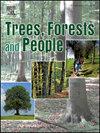How does camphor tree affect the wind and pollutants in the street canyon:a novel CFD method based on a point cloud algorithm?
IF 2.9
Q1 FORESTRY
引用次数: 0
Abstract
This study investigates the impact of camphor trees on airflow and pollutant dispersion in street canyons. As innovative research, it utilizes three-dimensional point cloud measurement data to extract and reconstruct tree TB (trunk and branches), establishing a mathematical model for the resistance source term that accurately describes the external morphology of the tree crown and the discontinuous, non-uniform characteristics of the internal leaves. This method addresses the challenges associated with accurately characterizing tree features. Based on this novel methodology, numerical simulations were conducted to investigate the effects of various tree characteristics and layouts on the wind environment and pollutant distribution in street canyons. The results indicated that the irregular distribution of camphor tree TB and crowns leads to significant differences in airflow patterns, flow velocities, and pollutant concentration across different cross sections of the street canyon. Whether only camphor tree TB or whole camphor trees (including crowns and TB) are present, neglecting the influence of tree TB results in an overestimation of the average airflow velocity and an underestimation of the average pollutant concentration at the canyon's bottom. This effect is particularly pronounced in areas with only tree TB, leading to a 14 % reduction in average airflow velocity. The obstruction effect of TB on airflow is diminished by the resistance effect of leaves. Furthermore, when considering the influence of camphor tree crown layout, the crown positioned in the middle of the street canyon has the most significant impact on airflow dynamics. The crown near the leeward side effectively increases airflow velocity and significantly reduces pollutant concentration at the bottom compared to the crown near the windward side.
樟树如何影响街道峡谷的风和污染物:一种基于点云算法的新型CFD方法?
研究了香樟树对街道峡谷气流和污染物扩散的影响。作为一项创新研究,利用三维点云测量数据对树木TB(树干和树枝)进行提取和重构,建立了准确描述树冠外部形态和内部叶片不连续、不均匀特征的阻力源项数学模型。该方法解决了与准确表征树特征相关的挑战。在此基础上,通过数值模拟研究了不同树木特征和布局对街道峡谷风环境和污染物分布的影响。结果表明:由于樟树结核和树冠的不规则分布,导致街道峡谷不同断面的气流形态、流速和污染物浓度存在显著差异;无论只存在樟树TB还是整棵樟树(包括树冠和TB),忽略树TB的影响都会导致对平均风速的高估和对峡谷底部平均污染物浓度的低估。这种影响在只有树结核的地区尤为明显,导致平均气流速度降低14%。叶片的阻力作用减弱了结核对气流的阻碍作用。此外,在考虑樟树树冠布局的影响时,位于街道峡谷中间的树冠对气流动力学的影响最为显著。背风侧的树冠与迎风侧的树冠相比,能有效提高气流速度,显著降低底部污染物浓度。
本文章由计算机程序翻译,如有差异,请以英文原文为准。
求助全文
约1分钟内获得全文
求助全文
来源期刊

Trees, Forests and People
Economics, Econometrics and Finance-Economics, Econometrics and Finance (miscellaneous)
CiteScore
4.30
自引率
7.40%
发文量
172
审稿时长
56 days
 求助内容:
求助内容: 应助结果提醒方式:
应助结果提醒方式:


